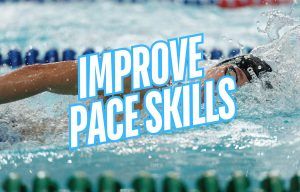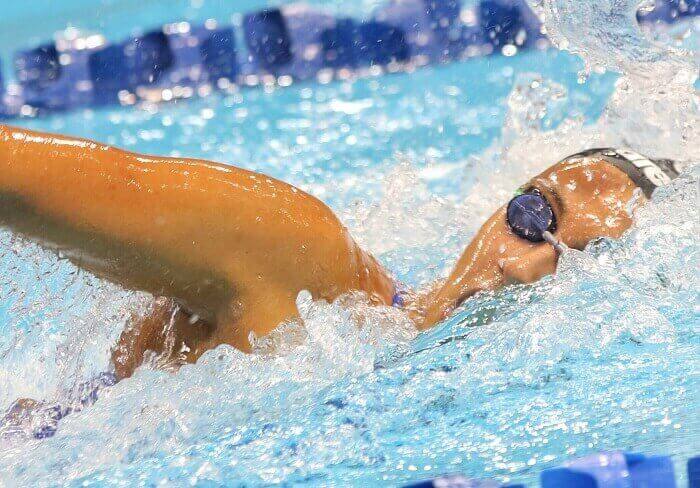
How to Improve Your Pacing Skills
Looking to up your pacing skills in the pool? Here are some actionable pacing tips and tools to help you master pace and your performance on race day.

Boost recovery, improve mood, and become a more flexible athlete. Here are just 5 of the many reasons yoga can help you become a better swimmer.
World class athletes and programs including NBA superstar LeBron James, legendary Duke coach Mike Krzyzewski, and the New Zealand All Blacks all swear by it.
So does Olympic champion Natalie Coughlin and countless other swimmers and teams.
While swimming has its own unique set of health benefits, yoga comes in hot with its own prized list of perks.
The benefits of yoga have been shown over and over again to be effective at increasing mobility, improving core strength, and perhaps most critically for swimmers looking to get an edge, shortening recovery times between sessions.
The benefits of yoga go far beyond the pool as well.
Research has shown yoga to have positive returns on stress levels, immune system function, and can even help to soothe anxiety and depression.
Here are 5 reasons to consider incorporating yoga into your swim training:
The repetition that comes with performing the same movements over and over and over again in the pool render our muscles tight, knotty and leads to limited function. Once this happens other local muscles are tasked to help complete the movement, opening yourself to the likelihood of injury, particularly the dreaded swimmer’s shoulder.
The common solution is to stretch after practice, but static stretching is kind of, well, boring. And most swimmers will use it as an excuse to chat instead of paying attention to what they are doing.
Yoga, with its combination of dynamic and static stretching is highly effective at releasing muscular tension, while also encouraging mindfulness and focus on the movements.
While most yoga poses (or “asanas”) don’t look outwardly challenging, they do require effort to control, meaning you will be mobilising warm muscles instead of sitting on a cold pool deck stretching muscles that are rapidly cooling.
For the casual observer doing yoga might not seem like it would develop strength.
There are no violent movements, no heavy weights, and no clanging of barbells and dumbbells.
But holding the poses will develop muscular endurance, challenges the stabilizer and core muscles (those are kinda important for swimming), and also improves overall, functional muscular strength.
Body awareness is critical to fast swimming.
In a sport as technical as ours there is a lot going on at all times. There is a laundry list of cues that we try to follow when we are in the water: maintain body line, enter with your fingers, pull down and not out, kick from your core, kick with loose ankles, and so on.
Doing yoga, and having to follow the instructions (“Pull your belly button into your spine” and so on) keeps you conscious of your movements and increases general body awareness.
Swimmers don’t just have to work hard at practice, they are in a seemingly never-ending battle between swimming workouts where they are racing to recover as fast as possible.
From doing a proper warm-down, to eating properly, to getting much-needed sleep, swimmers will do whatever they can to restore their body so that it is ready to perform at a high level as soon as possible.
Yoga has been shown to decrease inflammation at the cellular level, helping to kick-start the recovery and restorative process that helps get you back to full capacity sooner than later.
The most underrated and hard to measure benefits of yoga don’t necessarily appear in your training log or on the scoreboard.
It comes from helping you keep an even keel, regulate stress, and even improving your mood.
Doing yoga regularly has been shown to help you better regulate your emotions, something that can come in super handy in the moments behind the blocks at the big meet when your belly feels like it’s going to explode from butterflies. Or when you are neck-deep in a tough set and are feeling frustrated and unmotivated.
It goes without saying that having better control over your emotions will benefit you outside of the pool as well, helping you to de-stress and keep things in perspective.
The best thing about yoga is that there is a relatively low bar of entry.
There are classes and moves for every level of athlete. The versatility is hard to beat as well; you can drop some asanas just about anywhere at anytime. Expensive yoga pants, candles and yoga mats aren’t necessary.
Yoga is a great way to relax and restore your body after the rigors of swim training, and when united with your usual workouts it can provide for a more balanced—mentally and physically—athlete in and out of the water.
Weight Training for Swimmers: A Letter from Your Strength Coach. Some of the top strength and conditioning coaches from across the NCAA stop by to share their best advice for young swimmers making their first foray into the weight room.

Olivier Poirier-Leroy Olivier Poirier-Leroy is the founder of YourSwimLog.com. He is an author, former national level swimmer, two-time Olympic Trials qualifier, and swim coach.
✅ Free shipping on Orders over $49
✅ Price Match Guarantee
✅ Best selection of gear for training and competition
✅ Fast and Easy Returns

“This is the best book I have ever seen concerning mental training.” — Ray Benecki, Head Coach, The FISH Swim Team


Looking to up your pacing skills in the pool? Here are some actionable pacing tips and tools to help you master pace and your performance on race day.

Looking for tips on how to use a drag chute for improved swim performances? Read on for some proven tips, sets, and pointers for training with a chute.

Ready to take your swimming to the next level? Here are seven ways that a drag chute can help you become a better and faster swimmer.

Wondering if a swim bench can help improve your swimming? Here are six benefits of swim benches for better technique, more power, and faster swimming.

Not breathing into the walls is one of the fundamental skills developing swimmers are taught. Here is how powerful a no-breath approach is for turn and swim speed. Strong training habits are something swimmers hear a lot about from their earliest days of their competitive swimming careers. The greatest hits

Drills with a swim snorkel are one of the best ways to maximize engagement and skill development. Here are five swim snorkel drills to try for faster swimming.
SITE
SHOP
GUIDES

LANE 6 PUBLISHING LLC © 2012-2025
Join 33,000+ swimmers and swim coaches learning what it takes to swim faster.
Technique tips, training research, mental training skills, and lessons and advice from the best swimmers and coaches on the planet.
No Spam, Ever. Unsubscribe anytime.
